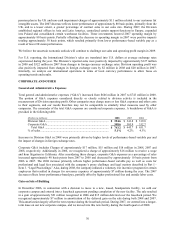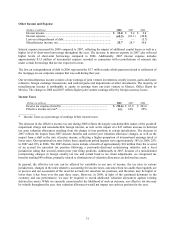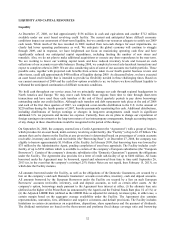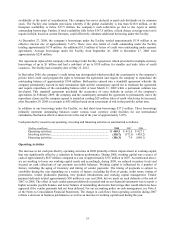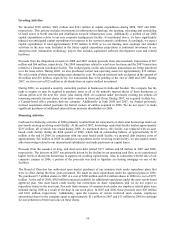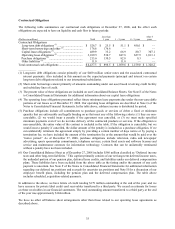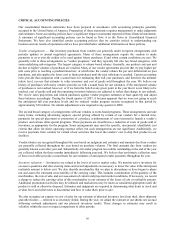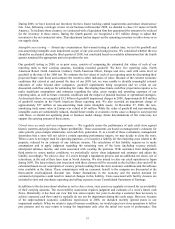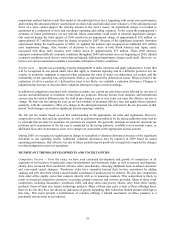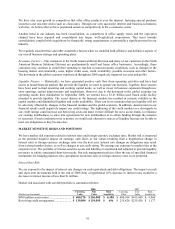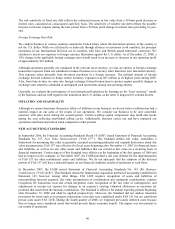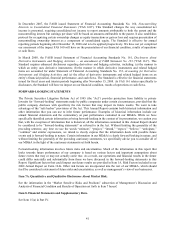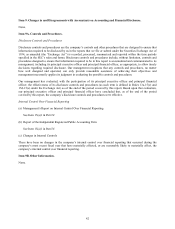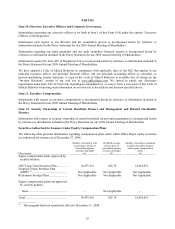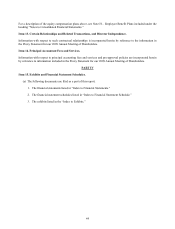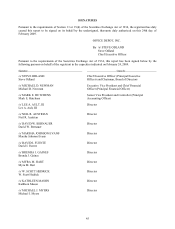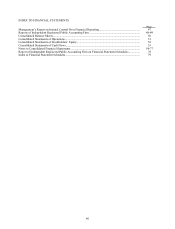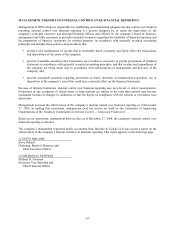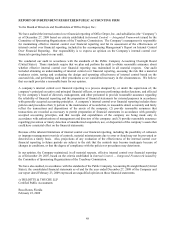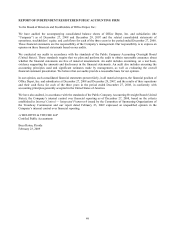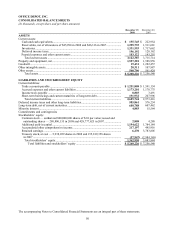Office Depot 2008 Annual Report Download - page 41
Download and view the complete annual report
Please find page 41 of the 2008 Office Depot annual report below. You can navigate through the pages in the report by either clicking on the pages listed below, or by using the keyword search tool below to find specific information within the annual report.40
The risk sensitivity of fixed rate debt reflects the estimated increase in fair value from a 50 basis point decrease in
interest rates, calculated on a discounted cash flow basis. The sensitivity of variable rate debt reflects the possible
increase in interest expense during the next period from a 50 basis point change in interest rates prevailing at year-
end.
Foreign Exchange Rate Risk
We conduct business in various countries outside the United States where the functional currency of the country is
not the U.S. dollar. While we sell directly or indirectly through alliances to customers in 48 countries, the principal
operations of our International Division are in countries with Euro and British pound functional currencies. We
continue to assess our exposure to foreign currency fluctuation against the U.S. dollar. As of December 27, 2008, a
10% change in the applicable foreign exchange rates would result in an increase or decrease in our operating profit
of approximately $16 million.
Although operations generally are conducted in the relevant local currency, we also are subject to foreign exchange
transaction exposure when our subsidiaries transact business in a currency other than their own functional currency.
This exposure arises primarily from inventory purchases in a foreign currency. The notional amount of foreign
exchange forward contracts to hedge certain inventory exposures was $83 million at its highest point during 2008.
Also, from time-to-time we enter into foreign exchange forward transactions to protect against possible changes in
exchange rates related to scheduled or anticipated cash movements among our operating entities.
Generally, we evaluate the performance of our international businesses by focusing on the “local currency” results
of the business, and not with regard to the translation into U.S. dollars, as the latter is impacted by external factors.
INFLATION AND SEASONALITY
Although we cannot determine the precise effects of inflation on our business, we do not believe inflation has had a
material impact on our sales or the results of our operations. We consider our business to be only somewhat
seasonal, with sales lower during the second quarter. Certain working capital components may build and recede
during the year reflecting established selling cycles. Additionally, business cycles can and have impacted our
operations and financial position when compared to other periods.
NEW ACCOUNTING STANDARDS
In September 2006, the Financial Accounting Standards Board (“FASB”) issued Statement of Financial Accounting
Standards No. 157, Fair Value Measurements (“FAS 157”). This Standard defines fair value, establishes a
framework for measuring fair value in generally accepted accounting principles and expands disclosures about fair
value measurements. FAS 157 was effective for fiscal years beginning after November 15, 2007 for financial assets
and liabilities, as well as for any other assets and liabilities that are carried at fair value on a recurring basis in
financial statements. Certain aspects of this Standard were effective at the beginning of the first quarter of 2008 and
had no impact on the company. In November 2007, the FASB provided a one year deferral for the implementation
of FAS 157 for other nonfinancial assets and liabilities. We do not anticipate that the adoption of the deferred
portion of FAS 157 will have a material impact on our financial condition, results of operations or cash flows.
In December 2007, the FASB issued Statement of Financial Accounting Standards No. 141 (R), Business
Combinations (“FAS 141R”). This Standard retains the fundamental acquisition method of accounting established in
Statement 141; however, among other things, FAS 141R requires recognition of assets and liabilities of
noncontrolling interests acquired, fair value measurement of consideration and contingent consideration, expense
recognition for transaction costs and certain integration costs, recognition of the fair value of contingencies, and
adjustments to income tax expense for changes in an acquirer’s existing valuation allowances or uncertain tax
positions that result from the business combination. The Standard is effective for annual reporting periods beginning
after December 15, 2008 and shall be applied prospectively. However, the Standard did not address transition
provisions for items such as in progress transactions costs that were capitalized under FAS 141 but are considered
period costs under FAS 141R. During the fourth quarter of 2008, we expensed previously deferred costs because
they no longer were considered assets that would provide future economic benefit. The impact was not material to
our results of operations.


